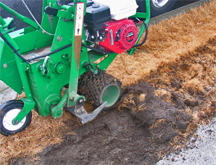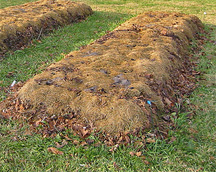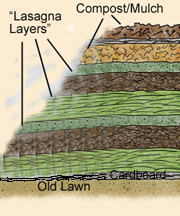
Grass Removal Methods
Removing a Lawn
Repeated droughts have motivated people to replace their lawns with alternatives that use less water. Sounds great, but what is the best way to remove your lawn? Listed below are several ways to remove turfgrass. The one you choose will depend on how large your lawn is, how much manual labor you want to invest, how much you want to spend, and what you plan to do with the area after the grass is gone. And lastly, how big of a hurry you are in. Methods can be broken down into quick and slow.
On the quick side, we have:
Herbicide
There are a number of herbicides that will kill turfgrass, but most are not substances that the Master Gardeners would endorse using, as they are residual and carry too much risk of eventually ending up in the water supply. Other choices, such as glyphosate (the active ingredient in widely available Roundup™), are much less residual, but this would be a very expensive way to remove your lawn. In short, we would not suggest using an herbicide for turf removal unless your lawn area was very small.
Physical removal

You can do the same thing in a small area with a flat shovel, but it is labor intensive.
Removing sod doesn't work if you have a persistent perennial lawn grass like Bermuda grass. Simply removing the sod on Bermuda guarantees that it will be back, since the roots go down for several feet, and it only takes an inch of root to grow it all back. In this case, the only way to get rid of the lawn is through solarization (or herbicides)—plus several months of waiting to be sure it's really gone.
The slower (but efficient and inexpensive) methods include:
Solarization
Technically, solarization is a method of soil sterilization using clear plastic, but a version, which might be called 'light exclusion' using black plastic, works for lawn removal. This method works best in areas with high summer temperatures, and should be done as spring is turning to summer. Cut the grass as short as possible and water well. Cover with large rolls of sturdy black polyethylene held in place by rocks or metal stakes. Cover the area, making sure it is airtight with no holes. The plastic sheets allow the sun's radiant energy to be trapped in the soil, heating the top 12 to 18 inches. When properly done, the top 6 inches of the soil will heat up to as high as 140°F, depending on the location. Leave in place for about 4-8 weeks—depending on how hot the weather is—until grass is dead. The high temperature may also kill some insects, plant diseases, nematodes and soil pathogens in the top layer of soil. Remove the plastic, and leave the dead grass to compost in place. This method also requires minimal labor and has minimal environmental impact. However, it takes a fair amount of time, must be done in hot weather and is unsightly.
Sheet composting
Cut the grass as short as possible. Cover the entire area with cardboard (either used boxes or purchased rolls) or newspaper (10-12 layers). Make sure that the edges overlap a goodly amount and no sunlight gets through the paper. Water paper, cover with a layer of compost, then mulch at least 4 inches thick. You can scatter grass and/or wildflower seeds in the compost if you're looking for a 'meadow' (before you apply the mulch). You can also cut holes in the paper to plant individual plants, or wait until the paper has decomposed and dig planting holes for your new plants. This method adds organic matter to soil, requires minimal labor, and does not require removal and disposal of turf. It also takes a fairly long time, and is not practical on steep slopes.

A variation on this theme is termed "lasagna gardening." Master Gardener and author Rosemary McCreary writes:
"In many cases, the lawn is the only open area that can absorb a new garden bed, but this may be the best place of all especially if you've been looking for a way to diminish the size of your lawn. Here's where the lasagna comparison enters the picture. The new planting site will be the resting spot of faded flowers and foliage of all types layered with kitchen scraps, fallen leaves, leftovers from the vegetable garden, and any other organics and soil you can scavenge."
The lasagna is essentially new soil created atop the lawn you wish to remove, consisting of layers of anything and everything you can find. Interleaving torn newspapers and cardboard with yard trimmings and clippings, kitchen scraps, bag-ends of potting soil, leaves, straw or hay—most anything organic creates it. Like compost, the lasagna should be roughly half "green" materials and half "brown."
McCreary continues: "Build your new bed up to 3 feet high in the center and let it slope a little lower toward the edges. Some recipes insist on a smattering of soil sprinkled on one or two layers of organics; others use a couple layers of manure to facilitate the breakdown of tough plant fibers."
Cover with a topping layer of compost and mulch, and water occasionally, if out of the rainy season (this method works best if done in the fall, taking advantage of winter rains, but can be done any time). Within six months "the new bed will have shrunk to half its height or less and will be ready for a final mulch coating after you finally set out all those plants that have been waiting for a permanent home," concludes McCreary.

Irrigation Conversion
Don't forget about your irrigation! Prior to starting on lawn removal, tag the sprinkler heads. Depending on the replacement planting, overhead sprinkling can be re-used—for example in the case of a natural meadow, or grass alternatives such as carex. Alternatively, the existing sprinkler locations can be converted to a drip irrigation system—if for example shrubs, natives, low-water or Mediterranean plants will be installed.
It is possible to use a combination of the above methods depending on your situation. For example you could remove small amount of sod near front door by hand so you can plant there right away, and light-exclude or apply sheet compost to a larger lawn area. But whichever method suits you, if you have areas of lawn that really aren't needed as lawn—start saving water, and money!
July 2021
©Sonoma County Master Gardeners







